World Cup Stadiums & Stats
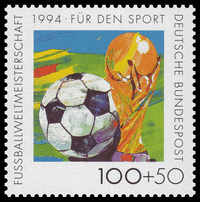 The FIFA World Cup is nicknamed ‘The Greatest Show On Earth’ because, in footballing terms, that’s exactly what it is. If the Champions League is the pinnacle of club level football then the World Cup is as good as it gets as far as international football is concerned.
The FIFA World Cup is nicknamed ‘The Greatest Show On Earth’ because, in footballing terms, that’s exactly what it is. If the Champions League is the pinnacle of club level football then the World Cup is as good as it gets as far as international football is concerned.
This section of the website is dedicated to telling you all about the World Cup and the stadiums that will be used throughout the next tournament in the USA, Canada and Mexico 2026. We’ll tell you about its history, the most famous tournaments, the rules of qualification and participation and the types of stadiums that have been used to host finals in years gone by.
Since 1930 the World Cup has been the highlight of international football and we’ll be letting you know all about why that’s the case.
If you would like to see previous World Cup stadiums, see our World Cup 2018 stadiums and World Cup 2022 stadiums pages.
World Cup Stadiums
| Stadium | Year Opened | Capacity | Ave Attendance | Record Attendance | Record Attendance Match |
|---|
World Cup 2026 Stadiums
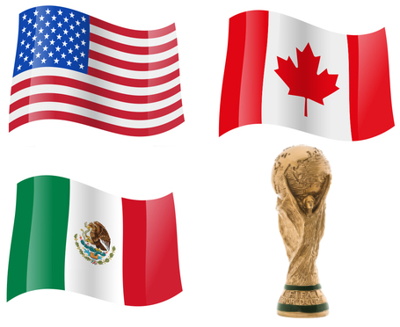 Contested by the Men’s teams from nations that are members of the Fédération Internationale de Football Association, the FIFA World Cup is seen as the pinnacle of international football. Inaugurated in 1930, the competition takes place every four years and teams have to go through a qualification process in order to earn the right to play in it.
Contested by the Men’s teams from nations that are members of the Fédération Internationale de Football Association, the FIFA World Cup is seen as the pinnacle of international football. Inaugurated in 1930, the competition takes place every four years and teams have to go through a qualification process in order to earn the right to play in it.
When the first version of the World Cup took place in Uruguay in 1950, only thirteen teams took part in it. That was because of the difficulty of travel at the time and only four of those thirteen teams came from Europe. It has grown and grown since those early days and the plan is for the competition to expand to include forty-eight teams from 2026 onwards.
The World Cup in 2026 is primed to be one of the most inclusive and spread out versions of the tournament ever, for reasons other than just the sheer number of teams that will be participating in it. It’s also due to be shared between three different host countries, which is something that hasn’t been attempted before in a World Cup.
On this page we’ll be having a look at how the tournament will work, how teams will qualify to play in it and the different stadia that could be used to host matches when the competition gets underway.

When the United Bid Committee released its initial list of possible stadiums that would be used for the World Cup, there were 49 venues that were on the list. Bids were later submitted by 31 cities, totaling 44 venues, which was cut down within a month. By February of 2018, this had been cut further to 26 venues before FIFA confirmed the 16 host cities in June of 2022. Mexico City is the only place chosen that is actually one of the capital cities of the host nations, whilst Estadio Azteca is the only stadium that was used in a previous World Cup, used as it was in both 1970 and 1986, with none of the 1994 World Cup venues being chosen.
When the host cities were chosen, they were split up into three geographical divisions, which were the Western Division, the the Central Division and the Eastern Division. Canada will have two stadiums during the World Cup, with Mexico getting three and the United States of America boasting 11 of the venues that are being used. Eight of the 16 football grounds that were chosen have artificial turf surfaces, which will be replaced by grass under the direction of FIFA alongside a research team from the University of Tennessee and Michigan State University. Four if them are indoors, boasting retractable roof systems.
Estadio Azteca – Mexico City, Mexico
The Building Process

When Mexico won the bid to host the 1968 Summer Olympics under the Presidency of Adolfo López Mateos, Estadio Azteca was seen as being a major sports venue where the final of the football tournament would be held. It was designed by architects Pedro Ramírez Vázquez and Rafael Mijares Alcérreca, with ground being broken in 1961 and the venue finally opening five years later. Back then, it had a capacity of 107,494 and the inaugural match hosted in it was between Club América and Torino F.C., finishing two all.
Over the years since, the stadium has undergone numerous different upgrades. This has included replacing seating in the venue, as well as electronic advertising hoardings being installed for use. Outside of the stadium, a commercial hub has been constructed by development firms IQ Real Estate and Alhel. Many of the internal developments were carried out in two phases, which saw the demolition of previous areas and the construction of new sections. These renovations resulted in the reduction of the seating capacity.
Stadium History
One of the factors about the Estadio Azteca that sets it apart from other venues is that it will become the first ever football ground to host three World Cups when it hosts a match in 2026. It is where Pelé lifted the Jules Rimet Trophy in 1970, with Maradona doing the same thing 16 years later. England fans will remember it as being the location where the Argentine scored his infamous ‘Hand of God’ goal against the Three Lions in the 1986 World Cup, but most other football fans will know that it is where he scored the ‘Goal of the Century’ in the same match.
Another World Cup match was also played in the Estadio Azteca, known as the ‘Game of the Century’. That was played during the 1970 World Cup and saw Italy take on West Germany in a match that ended up finishing 4-3 after extra time. What made it so special was the fact that all seven of the goals were scored in the extra time period, which is the most that has ever been scored in extra time in a World Cup game. It saw West Germany knocked out of the tournament, whilst Italy went on to lose to Brazil in the final.
Main Features
The Estadio Azteca is built in a bowl style, meaning that there should be decent views from pretty much every seat in the stadium. If you’re a fan of your World Cup history then you might want to take a wander around the venue and have a look at the bronze plaque that is there to commemorate the ‘Game of the Century’ between Italy and West Germany, which took place there in 1970. There is also one for the ‘Goal of the Century’ that Diego Maradona scored against England in 1986, plus a plaque with the namer of the first goal scorer and first match played there at night.
Significant Matches / Stages It Will Host
Estadio Azteca is one of the venues that is being discussed to host the opening match of the tournament, though no final decision has been made at this point. Obviously we’ll update this when final decisions have been taken.
Trivia
The name ‘Azteca’ is, as you might imagine, a tribute to the Aztec heritage that is such an important part of Mexico City. For a time in the 1990s, it was known officially as the Estadio Guillermo Cañedo in honour of a TV executive who had died. Few outside of the TV company that owned it called it by that name, however, and it was quietly reverted to its current name not long after. It is known locally as the Coloso de Santa Úrsula, or the Colossus of Saint Ursula, due to its large size and the fact that it is located in the suburb of Santa Úrsula.
Stats:
- What Groups Will The Stadium Be Used For? – Currently Unknown
- Highest Stage The Stadium Will Be Used For – Currently Unknown
- The Number Of Matches Hosted – Currently Unknown
- Capacity – 87,523
- Opened – 1966
- City – Mexico City
Met Life Stadium – New York / New Jersey, USA
The Building Process
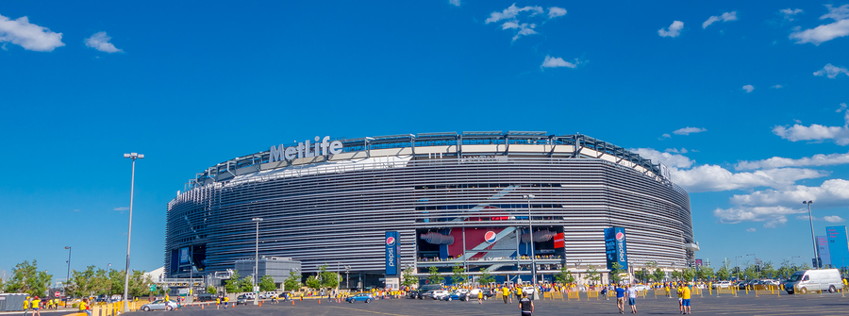
The Giants Stadium was one of the oldest stadiums that was used in the National Football League as it approached its 30th birthday. As a result, the Jets, who had been tenants to the Giants, decided to have a new venue built. It was supposed to be the stadium that would be used for the Summer Olympics bid of New York, but would have needed significant public money. As a result, a decision was taken by the Jets and the Giants to join forces in order to build a new stadium as a joint venture, with both being equal partners.
The architect chosen to carry out the job had to create a neutral stadium that still had features of both of the franchises that would be using it. This wasn’t easy, given the fact that the Jets liked a steel and modern look and the Giants preferred a traditional look with exposed steel and stone. The base has a limestone like stonework facade, with the rest of the ground using aluminium louvers and glass. Lights can be used to light up the stadium in particular colours, depending on which of the teams is playing in the venue.
Stadium History
Given the relative youth of the stadium, there isn’t as much history to speak of as there is in some of the other venues on this list. Even so, there are a few things worth mentioning, such as the 2012 decision to install a solar ring on the upper rim of the venue, which was designed thanks to a partnership between DLR Group and NRG Energy. This consists of 1,350 solar panels, which are illuminated in order to offer colours for the teams that are playing or other events taking place there. The panels produce excess energy, which is used to power other parts of the stadium or goes back into the grid.
When the decision was taken to seek naming rights, Allianz, who sponsor Bayern Munich’s stadium in Germany, expressed interest and offered between $20 million and $30 million for a 30 year sponsorship period. The local Jewish community protested against this thanks to the close relationship between Allianz and the Nazi Party during the Second world War. In the end, the New York based insurance company MetLife took on the responsibility of sponsorship, signing a 25 year deal on the 23rd of August 2011.
Main Features
In 2009, the Environmental Protection Agency named MetLife Stadium the ‘Greenest Stadium’ in the National Football League. Eight years later and it was given the title of the Venue of the Year by the Stadium Business Summit, which recognises the best sports venue on the planet according to performance over a 12 month period. One of the key factors of the stadium being picked as World Cup venue is the fact that it offers excellent sight lines regardless of where you are in the ground, which is impressive for an 82,500 capacity venue.
Significant Matches / Stages It Will Host
At the time of writing, we don’t know which stages of the World Cup will be held where. That being said, MetLife Stadium is one of the front runners to host the final thanks to its impressive location and capacity.
Trivia
A ‘memorandum of understanding’ was signed between the New Meadowlands Stadium Corporation and the EPA in June 2009, saying that environmentally friendly materials and practices will be used in the construction and operation of the venue. Interesting, despite its use as the home of both the New York Giants and the New York Jets NFL teams, the first official event at the stadium was the Big City Classic lacrosse event, which took place there in April of 2010. When the Giants played the Dallas Cowboys later that year, two power outages delayed play for 25 minutes.
Stats:
- What Groups Will The Stadium Be Used For? – Currently Unknown
- Highest Stage The Stadium Will Be Used For – Currently Unknown
- The Number Of Matches Hosted – Currently Unknown
- Capacity – 82,500
- Opened – 2010
- City – New York / New Jersey
AT&T Stadium – Dallas, USA
The Building Process
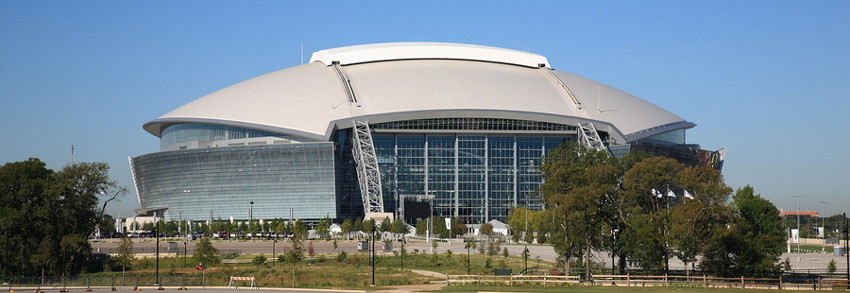
The original building costs for the AT&T Stadium were estimated at $650 million, but the eventual construction cost $1.15 billion. That tells a story of the difficulty in getting it finished, which was able to happen thanks to Arlington voters willingly seeing their taxes increase in order to pay for it. HKS Architects were responsible for getting it designed and built, with the lead architect role going to Bryan Trubey. There are two arches that span the length of the stadium’s dome and are anchored to the ground at each end, measuring nearly 300 foot.
Structural engineering firm Walter P Moore was behind the designing of the retractable roof, with mechanisation consultants Uni-Systems implementing it. It uses a special electrification system that was developed by VAHLE, Inc., employing genetic architecture fundamentals to allow for quick conversions of the facility. The field itself was built by Hellas Construction, who developed a specialised SoftTop Convertible Turf System in order to install 26 interchangeable panels to ensure that the venue can host a variety of different events.
Stadium History
Jerry Jones, the owner of the Dallas Cowboys, first suggested expanding the 65,000 seater Texas Stadium to more than 100,000 in 1994. Instead, a decision was taken to build a new venue, which was announced in 2004. It opened in 2009, hosting its first event then, which was a country music concert. Within two years it was the host of the Super Bowl, seeing the Green Bay Packers defeat the Pittsburgh Steelers. In 2015, it was the venue that hosted the first championship game in the era of the College Football playoff.
As well as countless NFL matches and numerous different music concerts, the AT&T Stadium, which is also known as the Cowboys Stadium but takes on its current moniker because of sponsorship, hosted WWE’s WrestleMania 32 in 2016. That particular event returned six years later when WrestleMania 38 took place there. The first sporting event to be hosted in the venue was the Gold Cup quarterfinal match between Costa Rica and Guadeloupe, which was followed up by a sold out game between Mexico and Haiti.
Main Features
The retractable roof is one of the most glaring examples of an interesting feature offered at the AT&T Stadium. It is also a multi purpose venue, so it can be used for the likes of basketball and football games, in addition to American football matches and concerts.
Significant Matches / Stages It Will Host
There is no clear information about which stages or significant matches it will be used to host at this stage.
Trivia
The Cowboys Stadium is often referred to either as Jerry World, after the owner of the Dallas Cowboys Jerry Jones, or else the Death Star. It was originally envisioned as an all purpose entertainment venue and can host as many as 100,000 people, depending on the event that it taking place. The deal over the naming rights was signed in 2013 when AT&T took it on, making it the third major sporting venue that is sponsored by the telecommunications company. In 2009, it was given a certificate by the Guinness Book of Records for the world’s largest HD video display.
Stats:
- What Groups Will The Stadium Be Used For? – Currently Unknown
- Highest Stage The Stadium Will Be Used For – Currently Unknown
- The Number Of Matches Hosted – Currently Unknown
- Capacity – 80,000 / 105,000
- Opened – 2009
- City – Dallas
Arrowhead Stadium – Kansas City, USA
The Building Process

Construction on the venue began in 1968, with a two stadium concept being put forward by Denver architect Charles Deaton and Jack Steadman. That is because it is part of the Truman Sports Complex, with Kauffman Stadium adjacent to it and offering baseball games for the Kansas City Royals. As well as the stadium itself, Lamar Hunt included an owner’s suite, which features bedrooms, bathrooms, living area and a kitchen. The Kansas City architectural firm of Kivett & Myers were responsible for implementing the design, with Sharp – Kidde – Webb responsible for construction as a joint venture.
Stadium History
The Dallas Texans played in the American Football League and were relocated to Kansas City in 1963, rebranding as the Kansas Chiefs. They initially played their games at the Municipal Stadium, sharing it with the Kansas City Athletics, a baseball team. A new stadium was needed when the AFL – NFL merger was announced because it could only house 35,000 people and all NFL stadiums needed to be able to seat no fewer than 50,000. So it was that a new sports complex was constructed, giving the Chiefs a new home.
Main Features
The football ground and the baseball stadium look very different from each other, but they actually share utilities as well as underground storage and parking facilities. The upper section was placed at a steep incline in order to limit the stadium’s overall footprint, meaning that it is built in such a way that wouldn’t be allowed in a modern stadium because of the accessibility restrictions.
Significant Matches / Stages It Will Host
This is unclear at the time of writing, but will be updated when that information is confirmed by FIFA.
Trivia
The stadium became the first in the National Football League to feature arrows on the yard markers, which indicate the ones nearer the the goal line. Eventually, this spread to the rest of the NFL before it became mandatory. In 2014, Chiefs fans were recognised as the noisiest in the world among outdoor stadiums, with noise reaching 142.2 decibels during a match between the Chiefs and the New England Patriots. When Major League Soccer formed in 1996, Arrowhead Stadium became the home of the Kansas City Wiz, which later became known as Sporting Kansas City.
Stats:
- What Groups Will The Stadium Be Used For? – Currently Unknown
- Highest Stage The Stadium Will Be Used For – Currently Unknown
- The Number Of Matches Hosted – Currently Unknown
- Capacity – 76,416
- Opened – 1972
- City – Kansas City
NRG Stadium – Houston, USA
The Building Process

The architectural firms of Hermes Reed Architects and Lockwood, Andrews and Newnam were teamed together in order to create the Houston Stadium Consultants. They worked together with Populous and engineers from Walter P Moore and Uni-Systems in order to utilise the principles of kinetic architecture. Ground was broken on the ninth of March 2000, with the official opening taking place on the 24th of August 2002. The surface of the pitch is a Hellas Matrix Helix.
Stadium History
In 1997, the Houston NFL Holdings Group approached Populous with the idea of building the first ever retractable roof in the National Football League. It was designed to replace the Astrodome, feating an open air facility that had the comfort and intimacy promised by an indoor arena. It opened in 2002 when a pre season game between the Miami Dolphins and the Houston Texans took place, with the first regular season match pitting the Texans up against the Dallas Cowboys a few weeks later. It was renamed as the NRG Stadium in 2014.
Main Features
The facility offers a sense of transparency from the outside, meaning that it appears to glow from within. It has a fabric roof and the use of glass throughout means that it feels like an open air venue when on the concourses. They are open to the field of play, whilst the venue has the ability to be configured in such a way that it will allow meeting, functions and exhibitions to take place. The roof mechanism is made up of two large panels that split apart, lying above each of the end zones when it is fully retracted.
Significant Matches / Stages It Will Host
At the time of writing, we don’t know which matches will be held here. We will endeavour to update this section when that information becomes available.
Trivia
There is a designated section of the north end zone bleachers for the home team, which is known as the Bull Pen. When Reliant updated their logo in 2011, they needed to update the signage all over the stadium. In December of 2012, it was announced that there was a plan to bring the Super Bowl back to Houston, with the plan being spearheaded by the installation of the biggest digital displays in any professional sports stadium. This was topped by the display boards at the TIAA Bank Field, which is the home of the Jacksonville Jaguars.
Stats:
- What Groups Will The Stadium Be Used For? – Currently Unknown
- Highest Stage The Stadium Will Be Used For – Currently Unknown
- The Number Of Matches Hosted – Currently Unknown
- Capacity – 72,220 / 80,000
- Opened – 2002
- City – Houston
Mercedes Benz Stadium – Atlanta, USA
The Building Process

Architect Bill Johnson created the stadium, being inspired by the Roman Pantheon for the circular roof opening. It was designed to be made of a clear material that can have its opacity adjusted in order to control the light coming in. There is a ring shaped video board called the Halo on the rim of the stadium, covering an area of 62,350 square feet. Part of the design allowed for two features that are specific to college football, with oversized locker rooms and staircases that connect seats to the field of play.
Stadium History
In May 2010, there was a suggestion that the Atlanta Falcons wanted a new stadium to replace the Georgia Dome. This was because of a desire to play outdoors, with an aim being that it would cost about $700 million. Numerous delays and problems meant that it didn’t open until August of 2017, eventually costing around $1.7 billion. It was worth the wait, with the stadium being used to host the 2019 Super Bowl as well as the 2018 College Football Playoff National Championship. It has also hosted numerous football matches, including the 2018 MLS All Star game against Juventus.
Main Features
The most obvious major feature of the Mercedes Benz Stadium is the retractable roof, which is made up of eight translucent, triangular panels that open on two rails. Closing the roof is quicker than opening it, largely because seals have to be disengaged when it opens. The idea is that the panels will resemble a bird’s extended wings when they are fully open. The roof can be open when it’s raining lightly, thanks to the fact that the electrical systems on the video boards of the displays are outdoor rated and there is a good draining system on the field of play.
Significant Matches / Stages It Will Host
It isn’t clear right now which games or stages of the World Cup will be played here, so we’ll update this section when we know more.
Trivia
There is a ‘soccer specific’ configuration at the stadium, which sees the seats on the lower section of the bowl retracted in order to widen the pitch. There is contemporary art incorporated into the exterior design of the venue, with more than 180 works having been commissioned to go on it. One such piece is a stainless steel sculpture of a falcon, which is perched on top of a 13 foot bronze American football and has a wingspan of 70 feet. It weighs more than 73,000 pound and is the same height as a four storey building.
As well as NFL matches, the stadium also hosts college basketball and football, being the home of the Major League Soccer franchise Atlanta United Football Club, in addition to the Atlanta Falcons National Football League team.
Stats:
- What Groups Will The Stadium Be Used For? – Currently Unknown
- Highest Stage The Stadium Will Be Used For – Currently Unknown
- The Number Of Matches Hosted – Currently Unknown
- Capacity – 71,000
- Opened – 2017
- City – Atlanta
SoFi Stadium – Los Angeles, USA
The Building Process

In 2016, the National Football League approved both the move of the Rams back to Los Angeles. It was then confirmed that Turner Construction and AECOM Hunt had won the right to build the new stadium in the Inglewood area of LA, which would be designed by the architectural firm HKS, Inc. As part of the plan, the Federal Aviation Administration needed to grant approval for the use of a rotary drill rig, thanks to the location of Los Angeles International Airport. The plan was to open it in 2019, only for rainfall to push that back by a year.
Stadium History
Given that the stadium only opened for the first time in September of 2020, it is fair to say that the main part of the history of the SoFi Stadium is yet to be written. Prior to the venue being built, the area was taken up by the Hollywood Park Racetrack, which was demolished to make way for the new sports ground. In addition to the Los Angeles Rams, the stadium is also the home of the Los Angeles Chargers, who play in the American Football Conference side of the National Football League. The stadium is part of Hollywood Park, a master planned neighbourhood development.
Main Features
Arguably the most interesting thing about the SoFi Stadium is the fact that it has a fixed roof. It is an independently supported translucent canopy, which covers not only the stadium but also the pedestrian plaza that stands adjacent to it as well as the performance venue that is attached. It is made up of 302 ETFE panels, of which 46 can be opened in order to provide some ventilation. There are 27,000 LED pucks that can be used to display videos and images that can even be seen from aircraft flying into LAX. Despite the fixed roof, there are open sides to the stadium, leaving it exposed to the weather.
Significant Matches / Stages It Will Host
As things currently stand, we don’t know exactly which matches or even stages of the World Cup will be hosted by SoFi Stadium.
Trivia
The SoFi Stadium is perhaps best known for the Infinity Screen that is suspended from the roof. It weights 2.2 million pounds and is a double sided 4K HDR video board, which is the first of its kind. As well as a 260 speaker audio system, ‘the Oculus’, as it is known, also houses 56 5G antennae. The fact that the SoFi Stadium was always intended to be the home of two NFL teams means that it uses an artificial pitch rather than grass. The stadium takes its name from SoFi, a San Francisco financial services company which has sponsored it for 20 years in a deal worth $30 million per year.
Stats:
- What Groups Will The Stadium Be Used For? – Currently Unknown
- Highest Stage The Stadium Will Be Used For – Currently Unknown
- The Number Of Matches Hosted – Currently Unknown
- Capacity – 70,240 – 100,240
- Opened – 2020
- City – Los Angeles
Lincoln Financial Field – Philadelphia, USA
The Building Process
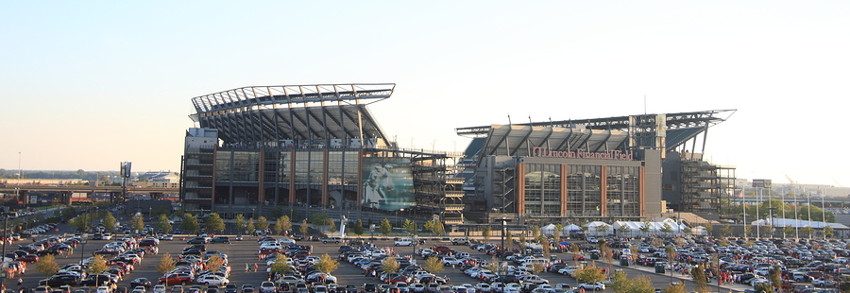
It took two years to build Lincoln Financial Field, with work beginning on the seventh of May 2001. It was designed to replace Veterans Stadium, which had previously been the home of both the Major League Baseball side the Philadelphia Phillies and the National Football League side the Philadelphia Eagles. Part of the reason for the move was in order to allow the stadium to have room for more wheelchair accessible seats as well as more luxury seats, with the actual number of people that can attend games being roughly the same as it was at ‘The Vet’.
Stadium History
Despite its use as the home stadium of the Philadelphia Eagles, Lincoln Financial Field’s first ticketed event was actually between Manchester United and FC Barcelona. The first American football match saw the Eagles take on the New England Patriots in a game that the home team lost 24 – 12. Manchester United and Barcelona aren’t the only football teams to play at ‘The Linc’, with the US Women’s Soccer Team playing there after winning the gold medal during the 2004 Summer Olympics, losing 3-1 to Denmark in front of 14,812 supporters.
Main Features
As is often the case in major American sports stadia, the Lincoln Financial Field is notable for the many light emitting diode video displays that are in place around the venue. On top of that, there is more than 624 feet of LED ribbon boards, which can be used for numerous different purposes. The purpose of the stadium’s design is to evoke the nest of an eagle, thanks to the ‘wing like canopies’ that are over the east and west stands, in addition to the ‘Eagle’s Nest’ balcony that sits about the end zone at the north end of the stadium.
Significant Matches / Stages It Will Host
We will update this section with the most significant matches and the likely stages that the Lincoln Financial Field will be hosting when that information becomes available, which it isn’t at the time of writing.
Trivia
When the first season of football took place at the Lincoln Financial Field, there was a ban imposed on cheesesteaks and hoagies. The club claimed that this was in relation to security concerns in the wake of the event of September the 11th. When the ban was widely mocked by sports radio, traditional media and fans, a decision was taken to end the ban and allow both foodstuffs into the stadium. The owners also tried to stop people taking part in tailgates from using tents and tables, putting the prices up on the spaces available for cars and RVs.
Stats:
- What Groups Will The Stadium Be Used For? – Currently Unknown
- Highest Stage The Stadium Will Be Used For – Currently Unknown
- The Number Of Matches Hosted – Currently Unknown
- Capacity – 71,896
- Opened – 2003
- City – Philadelphia
Lumen Field – Seattle, USA
The Building Process
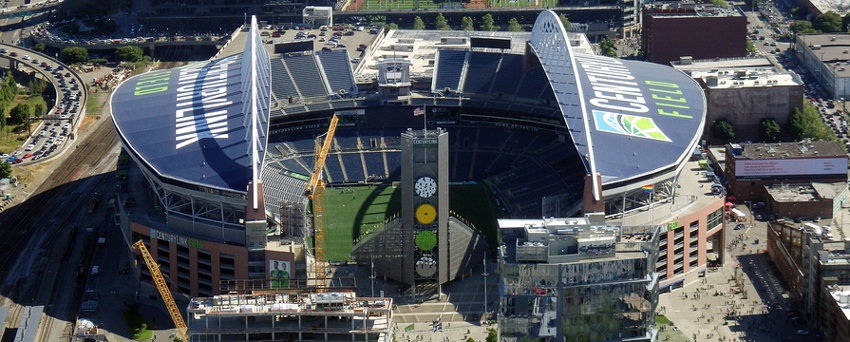
In 1997, a statewide election was held about the construction of a new stadium in Seattle to replace the Kingdome. As a result, the Washington State Public Stadium Authority was created, designed to oversee the public ownership of the new venue. Ellerbe Becket, an architectural firm, worked alongside Loschky Marquardt & Nesholm Architects of Seattle in order to design the stadium, with $81 million in business awarded to minority and female owned businesses. The ground that the new venue was built on was the smallest of all new National Football League stadiums at just 30 acres.
Stadium History
Though Lumen Field is predominantly thought of as an NFL stadium, it was also designed in order to be able to host ‘soccer’ matches. It has hosted friendly games of clubs including the likes of Manchester United, Barcelona and Celtic, as well as being the site of matches in the CONCACAF Gold Cup in 2006 and 2009. On top of that, it has hosted the likes of Supercross races, high school football thanks to the Washington Interscholastic Activities Association and, of course, numerous Seattle Seahawks NFL matches since it opened its doors for the first time in 2002.
Main Features
Part of the unique nature of the design of Lumen Field is the fact that the upper sections were cantilevered in order to fit over the lower sections and stick within the limited space available for the stadium. It is configured into a U shape, with the north end remaining open to as to provide views of downtown Seattle. It is also possible to see the retractable roof of the nearby T Mobile Park, in addition to Mount Rainier. The concourses were built to be wide, providing additional views of the surrounding areas of the rest of the city.
Significant Matches / Stages It Will Host
It is not possible to discuss the significant matches that will be hosted at Lumen Field, nor the stages that the venue will host, because that information hasn’t been confirmed yet by FIFA. This section of the site will be updated when that changes.
Trivia
Originally known as Seahawks Stadium, the venue became known as Qwest Field in 2004 when the telecommunications company sponsored it. It then became known as CenturyLink Field when Qwest was bought out by the company in 2011. In 2020, CenturyLink rebranded to become Lumen Technologies, so the venue took on its current moniker. As well as being the home ground of the Seattle Seahawks, it is also where the Major League Soccer side Seattle Sounders FC call home, in addition to the National Women’s Soccer League side the OL Reign.
Stats:
- What Groups Will The Stadium Be Used For? – Currently Unknown
- Highest Stage The Stadium Will Be Used For – Currently Unknown
- The Number Of Matches Hosted – Currently Unknown
- Capacity – 68,740 – 72,000
- Opened – 2002
- City – Seattle
Levi’s Stadium – Santa Clara, USA
The Building Process
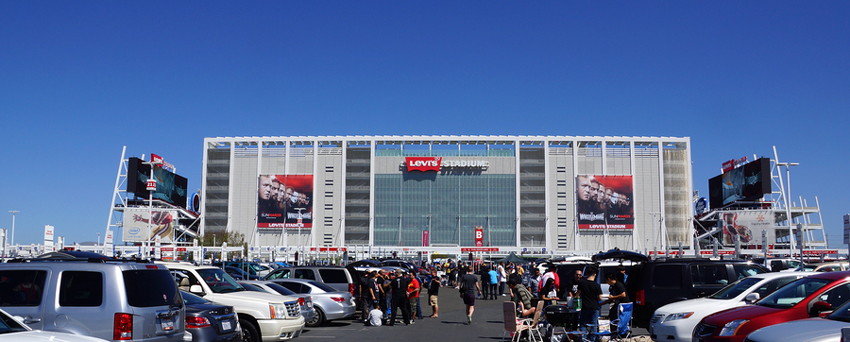
Construction of the stadium began in April of 2012, which was almost immediately after funding for the venue was confirmed. It was halted a little over a year later when a mechanic, who was working on an elevator, was stuck by a counterweight before falling to his death. The California Occupational Safety and Health Administration said that the site was safe two days later. The stadium was built on a parking lot that was owned by the city, but it does mean that there are very few amenities for sports fans close to the venue.
Stadium History
Having opened on the 17th of July 2014, Levi’s Stadium began hosting the home games of the National Football League side, the San Francisco 49ers. Levi Strauss & Co. bought the naming rights in 2013, with the venue boasting its current moniker ever since. It was the home of the Pac-12 Football Championship Game between 2014 and 2019, at which point that moved to Allegiant Stadium in San Francisco. It has been the venue used for the Super Bowl and is also where numerous football matches have taken place, thanks to the likes of the Seattle Sounders MLS team playing there.
Main Features
Unlike a lot of sports stadiums in the United States of America, Levi’s Stadium doesn’t have a roof. Though California is obviously known for its good weather all year round, this does leave it open to the elements. Around two thirds of fans are located in the lower bowl, thanks to the seating design, which can be expanded from 68,500 to 75,000 depending the event that is being hosted. There is an app that was designed for the stadium in order to provide a better fan experience, including live streaming, in seat delivery and navigation options, amongst other things.
Significant Matches / Stages It Will Host
At the time of writing, FIFA hasn’t confirmed which matches nor stages of the World Cup will be held in which stadiums. As a result, we cannot tell you what will be hosted here, but obviously we will endeavour to update this section as soon as that information is available to us and we’re able to do so.
Trivia
There have often been problems with the grass surface at Levi’s Stadium. In 2015, for example, the grass collapsed under Justin Tucker as he went to take a kick for the Baltimore Ravens. The stadium itself is one of the biggest buildings that is registered with the U.S. Green Building Council. It became the first professional football stadium in the US to receive a Leadership in Energy and Environmental Design Gold Certificate. It is also one of the first ones to have both a green roof and solar panels. The green roof was used to house an organically maintained rooftop farm, which happened in 2016.
Stats:
- What Groups Will The Stadium Be Used For? – Currently Unknown
- Highest Stage The Stadium Will Be Used For – Currently Unknown
- The Number Of Matches Hosted – Currently Unknown
- Capacity – 68,500 – 72,000
- Opened – 2014
- City – Santa Clara
Gillette Stadium – Boston, USA
The Building Process
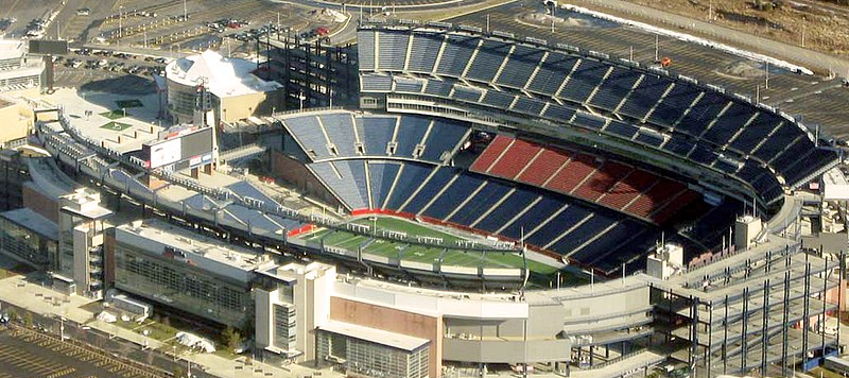
In April of 2000, a design team revealed plans for a new stadium located in Foxborough, just outside of Boston in the US state of Massachusetts. The plan was for it to cost $325 million to built, with enough room for 68,000 supporters. Alongside the building of the stadium, a new road, U.S. Route 1, was also built. Designed by Populous and modelled on the M&T Bank Stadium in Baltimore, there were around 200 designs produced before the owner, the Kraft Group, liked one. This was largely down to an insistence that it had a ‘front door’ to welcome people, similar to Disneyland.
Stadium History
For 30 years, the New England Patriots played their home games at Foxboro Stadium. That needed to be updated, not least of all because it was one of the smallest stadiums in the National Football League. The new venue was built and in the years that followed its opening it has noted the NFL’s Primetime Season Opening Game on several occasions. It has also seen college football games played in it, as well as ice hockey matches and the home games of the Major League Soccer team, the New England Revolution.
Main Features
In addition to the ‘front door’ that welcomes patrons, one of the most interesting aspects of the Gillette Stadium is the HD Daktronics video displays, that were constructed in 2010 and were second largest in the NFL at the time. In 2021, a memorial garden was built outside Gillette Stadium in order to commemorate the 20th anniversary of the September 11th attacks. A lighthouse was built in 2021, towering over the stadium at 218 feet tall, whilst new hospitality and function suites were built to connect all levels around the ground.
Significant Matches / Stages It Will Host
When we know what matches will be played here, we’ll update that information in this space. Similarly, we’ll let you know which stages of the World Cup will be hosted at the Gillette Stadium as soon as FIFA make a decision on that matter.
Trivia
No other venue in the National Football League ranks as highly as Gillette Stadium when it comes to food safety, with 0% critical violations at the time of writing. In 2022, a construction and renovation project at Gillette Stadium was announced, including the installation of a new video board at the north end that would become the biggest of its kind anywhere in the United States of America. The Patriots hosted seven playoff games at the venue between 2003 and 2007, winning all of them and not losing a playoff game there until the Baltimore Ravens defeated them 33 – 14 in 2010.
Stats:
- What Groups Will The Stadium Be Used For? – Currently Unknown
- Highest Stage The Stadium Will Be Used For – Currently Unknown
- The Number Of Matches Hosted – Currently Unknown
- Capacity – 68,878
- Opened – 2002
- City – Boston
Hard Rock Stadium – Miami, USA
The Building Process

The Miami Dolphins played their first 21 seasons at the Orange Bowl. In 1976, however, the city of Miami moved to quadruple the rent, so the team founded, Joe Robbie, began exploring was to build a new stadium. There was a belief that a Major League Baseball team would move to Florida at some point, so the new venue was built with a rectangular configuration. The field was wider than was common for National Football League venues, which also allowed ‘soccer’ to be played on it easily enough. It opened in 1987 in the then unincorporated Miami Dade County.
Stadium History
The Miami Dolphins played their first pre season game at the new stadium against the Chicago Bears on the 16th of August 1987. The first regular season game took place nearly two months later during the NFL strike, meaning that the team was made up of replacement players. At the time of writing, eight playoff games have been played at the venue, which has had numerous different names since it first opened. It has also been the home of the Florida Marlins baseball team as well as the location for numerous different Super Bowls over the years.
Main Features
The most interesting feature of the Hard Rock Stadium is the fact that it is so easily configured for different sports. The wide pitch means that everything from baseball to football can be played on it. Since 2016, it has had an open air canopy over it, which protects fans from the elements but not the players. The Baptist Health Training Complex was opened in 2021, which. The Dolphins moved into as their permanent site. It is also going to be a World Cup practice facility for one of the countries during the 2026 tournament.
Significant Matches / Stages It Will Host
As things currently stand, it is impossible to either confirm or deny which matches will be hosted at the Hard Rock Stadium. This is because FIFA have not yet decided which states of the 2026 World Cup will be held where, nor which matches will be hosted by what venues.
Trivia
Only a few Super Bowls have featured in excess of 70 points scored in total, but one of them was hosted at the Hard Rock Stadium. That was in 1995 when the San Francisco 49ers defeated the San Diego Chargers by 49 points to 26. One of college football’s most storied teams, the Miami Hurricanes, have called the venue home since 2008. When the 2013 BCS National Championship Game took place between Alabama and Notre Dame, a new attendance record of 80,120 was set for the stadium. At the time of writing, that remains the record for people in the venue.
Stats:
- What Groups Will The Stadium Be Used For? – Currently Unknown
- Highest Stage The Stadium Will Be Used For – Currently Unknown
- The Number Of Matches Hosted – Currently Unknown
- Capacity – 64,767
- Opened – 1987
- City – Miami
Estadio BBVA – Guadalupe, Mexico
The Building Process
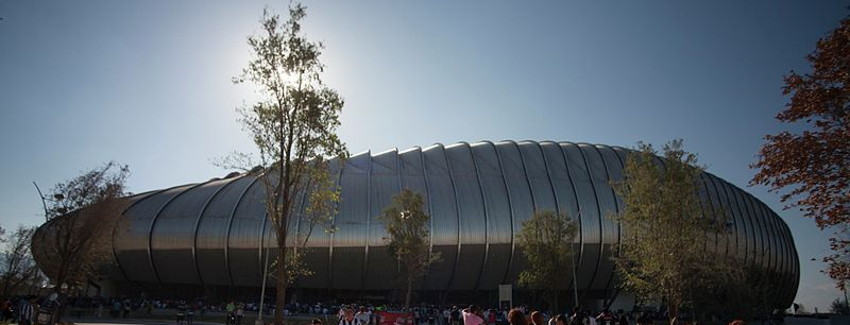
Designed by multinational architecture firm Populous, alongside the Mexican firm VFO, the lead design role was taken on by Christopher Lee. Construction got underway in the August of 2011, lasting for just shy of four years. When it opened, it boasted a capacity of 51,000, which made it the fourth largest in Mexico. Costing $200 million, it was the most expensive stadium in the country and the owners spent more adding extra seats in 2016. The grandstand sits at an inclination of 34 degrees, whilst the distance between the stand and the pitch is the minimum that FIFA will allow.
Stadium History
Nicknamed El Gigante de Acero, or ‘The Steel Giant’, the ground was formerly officially known as the Estadio BBVA Bancomer. It was built to replace C.F. Monterrey’s previous home, Estadio Tecnológico. When the stadium was built, it was a cause for controversy, owing to the fact that it had led to the deforestation of 24.5 hectares. The first match played at the new ground took place on the second of August 2015, when the eighth edition of the Eusébio Cup saw Monterrey defeat Benfica 3-0. In 2022, the stadium was used to host eight matches in the 2022 CONCACAF W Championship, including the final.
Main Features
Given the nickname of the stadium as ‘The Steel Giant’, is perhaps somewhat unsurprising that the main feature of the venue is the look of exposed metal that goes all the way around it. Within the ground itself there are numerous aspects that are aimed at the higher paying fan, including a club themed restaurant, club lounge and hospitality suites. The fact that the stands are as close to the pitch as FIFA will allow means that matches that are played here tend to take place in a hostile environment, with supporters feeling as though they are close to the action.
Significant Matches / Stages It Will Host
This section of the website will be updated with the relevant information once FIFA have decided which matches will be played where. At the time of writing, that is something that we don’t know, given that the World Cup organisers have yet to decide which stages of the tournament each stadium will play host to.
Trivia
The entire remit of the stadium is to boast a sustainable nature, which was reflected in the fact that it was awarded a silver certificate from the Leadership in Energy and Environmental Design group. In fact, it was the first football stadium that is based in North America to receive such a commendation. This is largely thanks to the fact that more than one third of the total land area of the stadium are green areas. They are used to filter rainwater, which recharges the aquifers. The parking areas are integrated into the landscape and topography around the ground.
Stats:
- What Groups Will The Stadium Be Used For? – Currently Unknown
- Highest Stage The Stadium Will Be Used For – Currently Unknown
- The Number Of Matches Hosted – Currently Unknown
- Capacity – 53,500
- Opened – 2015
- City – Guadalupe
Estadio Akron – Zapopan, Mexico
The Building Process
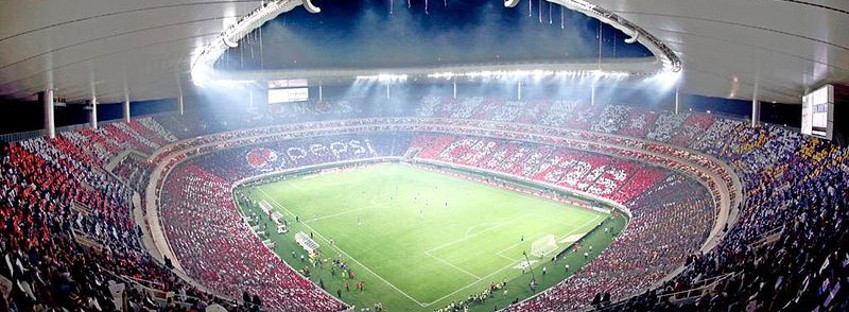
Construction on the stadium began in the February of 2004, but there were numerous financial issues as well as other problems that meant that the opening of the ground was constantly delayed. In fact, it ended up not opening officially until the 30th of July 2010, more than six years after the builders broke ground. It is part of the wider JVC complex of sporting venues. The nature of the building process as well as its location in Mexico meant that it was built with an artificial grass field, rather than with real turf as you might expect.
Stadium History
C.D. Guadalajara played their matches in the Estadio Jalisco. In February of 2004 it was announced that they intended to construct a new stadium as a replacement. Once it had opened in 2010, it saw its first official match open to the public take place between Guadalajara and Manchester United, with the home side winning 3-2. The match took place because of the transfer of Javier “Chicharito” Hernández to the English side, so it is fitting that he scored the opening goal. Indeed, he switched sides at half time, playing for both teams during the game.
Main Features
One of the most obvious features of the stadium was the artificial turf that was used for its playing surface. This drew criticism from most quarters, resulting in a decision to replace it with real grass in 2012. The stadium itself looks like something from a futuristic movie from the outside, thanks to the fact that the roof stands on what look like stilts above the main body of the ground. This means that it is elevated above the area of the stadium that the supporters go into and the roof offers very little protection from the elements.
Significant Matches / Stages It Will Host
Though we know that the stadium has been selected to host some matches during the 2026 World Cup, we don’t actually know which ones at present. We will look to update this section when that information becomes available.
Trivia
During the 2011 FIFA Under 17 World Cup, the stadium was used to host numerous matches, including the Semi Final between Uruguay and Brazil, which Uruguay won before going on to lose to Mexico in the Final. It was also used for the opening and closing ceremonies of the Pan American Games in the same year. Previously known as the Estadio Omnilife, the name of the venue was changed to Estadio Akron in 2017 after a sponsorship deal was signed with the car lubricants firm, who agreed to sponsor it for 10 years.
Stats:
- What Groups Will The Stadium Be Used For? – Currently Unknown
- Highest Stage The Stadium Will Be Used For – Currently Unknown
- The Number Of Matches Hosted – Currently Unknown
- Capacity – 48,071
- Opened – 2010
- City – Zapopan
BC Place – Vancouver, Canada
The Building Process

Dillingham Construction were contracted to build the stadium, with work starting in 1981. It was designed by architecture firm Studio Phillips Barratt Limited and was created as part of the preparations for the World’s Fair in 1986. It was completed in 1983 and the work, designed by structural engineers Geiger Berger Associates, meant that it was the first air supported dome in the world. That remained the case until it was deflated for the final time in 2010, after which a retractable roof was built on top of the venue to give it more structure.
Stadium History
The stadium opened its doors for the first time on the 19th of July 1983, hosting its inaugural major event the following day. That saw the Vancouver Whitecaps take on the Seattle Sounders as part of the North American Soccer League. It was used as the venue for the opening and closing ceremony for the World Exposition on Transportation and Communication in 1986. As well as Canadian Football League and MLS matches, the stadium has also been the home of the Canada Sevens, which is part of the World Rugby Sevens Series, in addition to the BC Sports Hall of Fame.
Main Features
The retractable roof, which is supported by cables, is one of the most obvious features of the stadium. It replaced the air supported roof in 2010 after the venue was closed for 16 months to install it. It boasts a scoreboard, which hangs in the centre and is the second largest in North America, beaten only by the one at the AT&T Stadium. It was built in a baseball configuration, which was in order to try to attract a franchise from the Major League Baseball. There are two SkyTrain stations that serve the venue, with one in the east and the other in the west.
Significant Matches / Stages It Will Host
Once FIFA have decided which matched and stages of the 2026 World Cup will be hosted where, we’ll update this section accordingly.
Trivia
BC Place was the main stadium for both the 2010 Winter Olympics and the Winter Paralympics the same year. Two years on and it was the location of the CONCACAF Women’s Olympic Qualifying Tournament. In 2015, the FIFA Women’s World Cup saw a championship match played in the venue, so it has already experienced a World Cup prior to it hosting World Cup matches in 2026. In 1984, Pope John Paul II addressed an over capacity crowd as he hosted what was known as ‘A Celebration of Life’ as part of the papal visit to the Archdiocese of Vancouver.
Stats:
- What Groups Will The Stadium Be Used For? – Currently Unknown
- Highest Stage The Stadium Will Be Used For – Currently Unknown
- The Number Of Matches Hosted – Currently Unknown
- Capacity – 54,405
- Opened – 1983
- City – Vancouver
BMO Field – Toronto, Canada
The Building Process
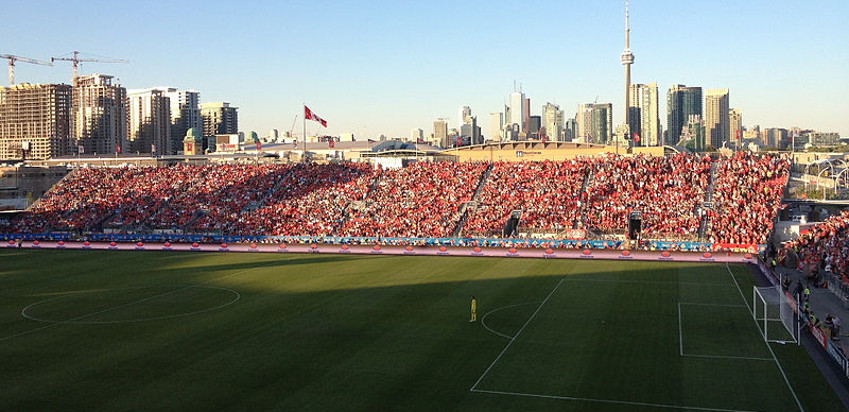
Exhibition Place had been the exact location for four other stadiums before BMO Field opened. Several proposals around the idea of a stadium had been put forward in the 2000s, with slight confusion existing over what type of venue would be opened. In the end, a football specific stadium was constructed at the site of Exhibition Place. The finances for the cost of constructing the venue came from numerous different places, including $27 million from the Canadian Federal Government and a combined $17.8 million from the governments of Ontario and the City of Toronto.
Stadium History
Toronto Football Club played their opening game at BMO Field on the 28th of April in 2007. The following year, it was the venue that was used for the All Star game of Major League Soccer, involving the best players from the MLS that season and Premier League side West Ham United. It has been the stadium for the final of numerous MLS Cups and in 2014 it was where the opening match of the 2014 International Champions Cup took place. The first major tournament held at the venue was the 2007 FIFA Under 20 World Cup.
Main Features
One of the most notable features of BMO Field is that, unlike most stadiums in North America, it is not built in the bowl style. Instead, it s much more like British stadiums, which have four distinct stands on each side of the pitch. Numerous renovations took place between 2014 and 2016, including the addition of an upper deck on the eastern grandstand and a roof over the various seating areas. The field was also lengthened in order to allow it to host Canadian football matches, meaning that it is one of the country’s best venues in terms of covering numerous different sports.
Significant Matches / Stages It Will Host
As things currently stand, there is no way to know which stages of the World Cup it is likely to host. Equally, we can’t tell you much about the matches that will be played here. That being said, knowing FIFA, it will be used for whichever country will find it the most difficult to get to it.
Trivia
BMO Field has seen three different types of surface used on it during its time. When it first opened it had FieldTurf, then in 2010 that changed to Kentucky Bluegrass. In 2019, a hybrid grass system was employed, which has been there since. It not only hosts football matches for Toronto FC, it is also somewhere that the Toronto Argonauts can play their CFL games. As well as football and Canadian football, the venue has also been used to host rugby union games in addition to Lacrosse, hockey and some concerts. Eddie Johnson scored the first goal in a football match, which he managed for the Kansas City Wizards.
Stats:
- What Groups Will The Stadium Be Used For? – Currently Unknown
- Highest Stage The Stadium Will Be Used For – Currently Unknown
- The Number Of Matches Hosted – Currently Unknown
- Capacity – 27,456 – 40,000
- Opened – 2007
- City – Toronto
Tournament Format
Why The Tournament Is Expanding To 48 Teams?

In 1982 the World Cup was expanded to allow twenty-four teams to play in it. This was seen by many as the peak number of sides that should take part in the competition, resulting in a decent quality of matches thanks to qualification phases that separated the wheat from the chaff. In 1998 it was decided to expand the World Cup to allow thirty-two teams to take part in it, giving the opportunity for more sides from Asia, North America and Africa to play. Whilst many accept that it has indeed led to an increase in teams from those regions making it deeper into the competition, with the likes of Cameroon, South Korea, Senegal, the USA and Costa Rica all making the quarter-finals over the years since, many consider the inclusion of extra nations to have watered down the World Cup in recent years.
It’s entirely fair to ask, therefore, why FIFA have felt the need to expand the competition even further from 2026 onwards. A lot of it comes down to promises made by the former President of FIFA Sepp Blatter, with the now disgraced Swiss administrator writing in FIFA Weekly in 2013 that he would like to see ‘globalisation taken seriously’ and that the African and Asian confederations should be ‘accorded the status they deserve’ at future World Cups. That year the then-UEFA President, Michel Platini, decided that he would challenge Blatter for the Presidency and confirmed plans to extend the World Cup to allow forty nations to take part in it. Interestingly, he said that the World Cup is ‘not based on the quality of the teams’, which goes against the grain for many football lovers.
Both Platini and Blatter were courting the votes of the various federations in their hope of being elected as the leader of FIFA moving forward. Two years later and the organisation was rocked by corruption scandals, including the idea FIFA officials had been taking bribes in order to award the hosting of the World Cup to the nations willing to pay them the most money. Sepp Blatter and Michel Platini were both arrested and left FIFA under a cloud, whilst Gianni Infantino was elected to replace them. He announced in 2016 that he’s actually prefer the World Cup to expand enough to welcome forty-eight different nations, with FIFA taking a vote on that matter in January of 2017 and confirming that that would be what will happen from 2026 onwards.
The hope is that the expansion will allow nations from the likes of Asia, North America and Africa to feel as though they’re more involved in the World Cup, expanding the competition to truly be for the ‘world’. The risk is that the level of the tournament may drop by having so many teams entering from the start. Prior to the expansion being voted upon in 2017, tournament qualifiers would see the lesser teams exit the competition before it had actually properly begun. That resulted in the finalists in every World Cup since it began coming from either Europe or South America, which the FIFA officials behind the idea of an expansion are hoping will cease to be the case in the future. It’s difficult to envisage how allowing more teams to qualify even though they weren’t good enough to get into the competition when less teams could will result in different winners of the competition, but that remains the hope of its organisers.
Qualification
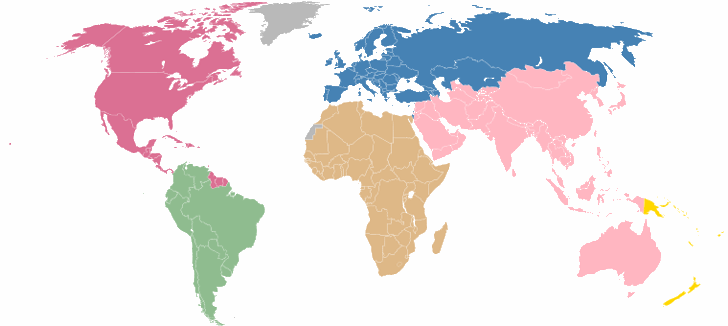
Qualification for the World Cup involves tournaments within the tournament. It is decided in advance how many teams will be competing in the tournament proper, with 48 being the number taking part since 2026. The initial stages of qualification, then, are about thinning down the field from 211 countries eligible to get involved to the amount needed to head to the finals.
FIFA is broken up into six different continental zones. These are, namely, Africa, North and Central America and the Caribbean, South America, Asia, Oceania and Europe. How many teams qualify from each zone for the World Cup is decided in advance and is based around the relative strength and competitiveness of of the teams in each confederation. The only team to get an automatic place in the tournament proper is the host nation; since 2006 not even the previous tournament’s winners get a free pass. If two or more nations jointly host the World Cup then they both get a place.
For the 2026 World Cup here’s how the numbers will work:
- Asian Football Confederation (AFC): 8 places from forty-six members
- Confederation of African Football (CAF): 9 places from fifty-three members
- Confederation of North, Central American and Caribbean Association Football (CONCACAF): 6 places from thirty-five members, with three of those places already defined for the hosts in 2026 (Mexico, Canada and United States)
- Confederación Sudamericana de Fútbol (CONMEBOL): 6 places from ten members
- Oceania Football Confederation (OFC): 1 place from eleven members
- Union of European Football Associations (UEFA): 16 places from fifty-five members
The more eagle-eyed amongst you will have noticed that eight Asian teams, nine African sides, six North and Central American nations, six South American teams, one from Oceania and sixteen from Europe adds up to forty-six, which will leave the competition short by two teams given that it’s being expanded to include forty-eight of them. That’s because an additional two places will be awarded via a World Cup inter-confederation play-off tournament.
This will involve one nation from every confederation playing in a knockout tournament, which will also double as a test event for the three host nations. The only confederation that won’t be invited to send a team along is UEFA. The five teams, along with one from CONCACAF, will go head-to-head in order to see which team will make it to the World Cup finals proper. Two teams will be seeded and four will be unseeded, with the unseeded sides playing each other for the right to play against the two unseeded teams in two mini-finals. The winners of those two matches will then take up the last two places.
The format change has increased slot allocation by 50% vs the previous 32 team tournaments. This works out best for Oceana who see a 167% increase in slot allocation, CONCACAF 90%, CAF 87%, AFC 85%, CONMEBOL 41% and UEFA 23%. Still, in spite of the increases Oceana only has 12% of members represented in the finals versus 63% from CONMEBOL. UEFA has 29% of its members at the tournament, CONCACAF 19%, AFC 18%, and CAF 17%.
| Continental Confederation Qualification Formats | |
|---|---|
| Africa | 2026 format yet to be decided. In the previous tournament a preliminary round narrowed the possible teams from 52 to 40 before these teams played each other in round-robin matches in 10 groups of 4 teams. The 10 winners played against each other at random, with the winners of those games qualifying for the finals. |
| Asia | Two knockout rounds reduce the 46 eligible teams to 18. A group stage then pits 3 groups of 6 teams against each other in a round-robin format with the winners and runners-up advancing to the World Cup (6 places) and the 3rd and 4th placed teams progressing to round 4. In the next round the 6 teams from round 3 are divided into two groups of 3, these play in a round-robin with the two winners qualify for the World Cup finals (2 places). The group runners up from round 4 compete in a play off to determine one team that will progress to the inter-confederation play-offs (1 possible additional place). |
| Europe | The 53 eligible teams are split into 12 groups of either 4 or 5 teams. The group winners qualify for the World Cup and the runners-up enter a play-off against each other, which will whittle those 12 down to the final 4 places. |
| North and Central America and the Caribbean | Three of these nations already qualify as hosts. Teams ranked 29-32 enter at round 1 in a two-legged play off. Those two winners join teams ranked 1-28 in round 2, consisting of 6 groups of 5. The 6 winners and 6 runners up progress to round 3 and are divided into 3 groups of 4. The three winners progress to the World Cup and the two best runners up enter the inter-confederation play-off. |
| Oceania | 2026 format yet to be decided. In the previous tournament the 2011 Pacific Games decided which teams would advance to a group stage to play with New Zealand. That was called the 2012 OFC Nations Cup and the winner entered the inter-confederations play-off. |
| South America | The least complicated confederation, South America have a single group that all the 10 nations enter. The top six teams go to the finals and the seventh placed team enters the inter-confederations play-off. |
How The Tournament Itself Will Work
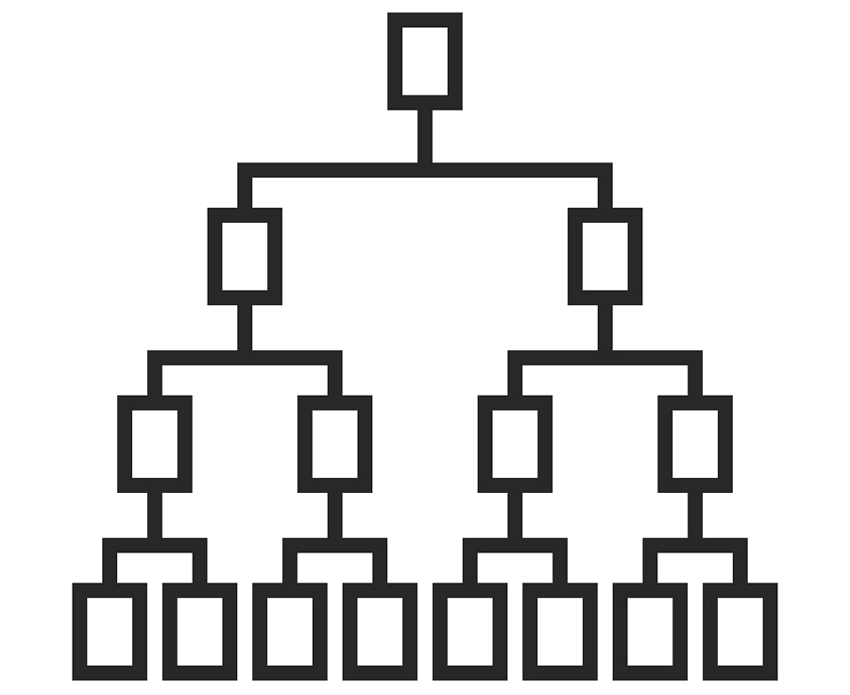
When the suggestion was first mooted to expand the tournament from the thirty-two team format that had been in place since 1998, numerous possible options were considered. Ten groups of four teams for a forty team tournament was one, as was a forty-eight team expansion that would have a playoff round for thirty-two teams to begin the competition. In the end, a format that would see sixteen groups with three teams in each for a total of eighty matches was chosen, but then abandoned after World Cup 2022. The original idea was the top two teams from each group would move forward to the knockout stage, which will start with thirty-two side rather than sixteen that enter the knockouts in the present format. That would have produced 80 games in total (48 group and 32 knockout).
Those that were opposed to the expansion of the tournament were concerned about the lack of quality in the initial stages of the competition. It was also felt that sixteen teams having to head home after just two matches was something of a waste of time for them, as well as likely failing to engage the viewers at home in the nations that don’t progress to the knockout phase. It was also likely to involve tactics being used in the second game of the group stage. When the second match got underway, it would have been between a team that hadn’t yet played against a team that had. If the team that had won their first game then they would know that they only need a draw to progress. If they lost, however, they would have to win the second game in order to progress to the knockout stage of the tournament.
Those that support the expansion actually suggested that it was actually something of a cheat way to get so many teams involved, given that there aren’t all that many extra matches that need to be played.
Therefore, following the 2022 World Cup FIFA made the decision to expand the event even more by reverting back to groups of four in the group stages. There will now be twelve groups of four teams playing three matches each, six in total per group and 72 group games overall. The top two teams enter the new round of 32 knockout phase along with the eight best third-placed teams. In total there will now be 104 games at the World Cup and it will have to be one week longer, at 39 days, to accommodate all the matches.
The hosts and highest ranked nine other nations are seeded into the groups. For the knockout phase the twelve group winners and four best runners up are seeded and drawn against the four other runners-up and eight selected third placed teams.
The two teams that make the final will still have to play seven games apiece to get there with the final being the eighth they would play, which is one more than in the past. Also, as with the current format, all teams will play at least three matches, so it’s only the sixteen worst sides in the competition that will go home early. This is likely because of the European Club Association’s complaint that the World Cup already asked players to play more games than they felt was acceptable. The President of the Liga de Fútbol Professional, Javier Tebas, agreed with them and said that Infantino has proposed the move to forty-eight teams for political rather than footballing reasons – we can’t disagree with him there.
Regardless of the reasons behind the expansion and the manner in which FIFA hope the tournament will pan out, the 2026 World Cup will work as follows:
- Twelve groups of four teams, top two from each progress along with the eight best third-placed teams
- Knockout stage of thirty-two teams
- Sixteen sides progress to next round
- Eight teams move into the quarter-finals
- Four teams play in the semi-finals
- Two teams compete in the final, whilst the other two play in a third-place, fourth-place play-off
The Group Stage
The format of the World Cup as it currently is has been in place since 2026. Once the 48 teams for the finals have been chosen by their respective confederations they are split into 12 different groups, each containing four national teams. Twelve teams get seeded for the group stage, with the hosts getting seeded automatically and the other nine teams seeded according to a complicated formula that works out the FIFA World Rankings of the teams and their previous World Cup performances.
The twelve seeds are each put into a pot for the group draw, with the remaining 36 teams separated into the different pots based on based on their geographical location. Teams are drawn from each pot at random to decide the make-up of the different groups. No group will feature more than two European teams or more than one team from the other confederations.
The group is then played out in a round-robin style tournament, during which each team plays three games against the other teams at random venues somewhere in the host nations. The final group game takes place at the same time in order to ensure no team has an advantage of knowing whether or not they’ve made it our of the group before a ball is kicked. The top two teams of each group make it through to the knockout stage of the tournament along with the 8 best runners-up.
The Knockout Stages
Unlike with most knockout tournaments, the path to the competition’s final is worked out before the World Cup itself begins. It is decided in advance that the winners of Group X will play the runners-up of Group Y, and so on. That means that teams often know that they will get an easier draw in the last 32 phase of the competition if they qualify for the knockout stages as group winners or one of the four best runners-up.
The knockout stage is a series of one-off matches, with the outcome of the game decided on the day of the match without the need for a replay. That means that if the game is a draw at the end of 90 minutes of play then it will go a period of extra-time. If the result is still undecided then a penalty shoot-out will take place.
As the route to the final has already been decided before the knockout stage gets underway teams know who they may face in the quarter-finals. For example, the winner of Match X will play the winner of Match Y, etc. That system continues all the way to the final, with the semi-final matches worked out in the same manner. The knockout matches will, as is the habit in tournaments, result in just two teams left standing who will compete in the final.
The Final
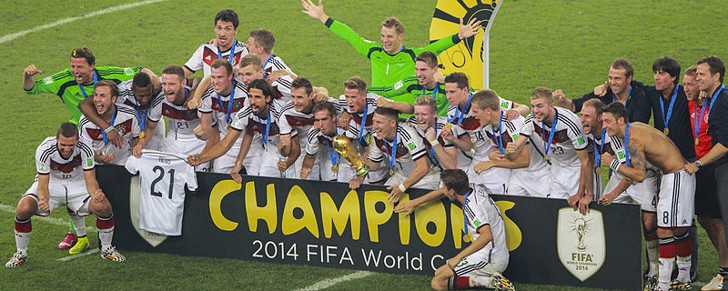
The two teams that were victorious in the semi-final stage go up against each other in the World Cup final. This is the showpiece event of the entire tournament and is regularly watched by hundreds of millions of people across the globe. Just like with the earlier rounds, the final of the World Cup is a one-off match that will not go to a replay. The winner of the tournament is decided on the day, with extra-time and penalties employed if necessary.
Unlike with most tournaments in club football, the third and fourth placed teams are also decided in the World Cup. This involves the two teams that lost in the semi-final stage playing against each other. The winner of this game is declared to have finished third and the loser finishes fourth. The loser of the final itself is the second-placed team and, somewhat self-explanatorily, the World Cup winners are the first-placed team.
How The 2026 Host Nations Were Selected

Ever since the corruption allegations surrounding FIFA and its selection process emerged, there has been much interest in the manner in which the organisation selects its host nations for World Cup tournaments. Between 2013 and 2017 they kept changing their mind about whether or not a country from within the same confederation as the last two host nations could be selected, with exceptions to this coming in if the nations that made a bid failed to fulfil FIFA’s requirements. Gianni Infantino conformed in 2017 that neither Europe nor Asia would be allowed to bid to host the 2026 tournament after Russia had been selected as the host for 2018 and Qatar was chosen for 2022.
The result was that just four confederations could bit to host the 2026 version of the tournament, which were CONCACAF, CAF, CONMEBOL and OFC. CONCACAF had last hosted a World Cup in 1994 when the USA had the honour, whilst CAF did so in 2010 when South Africa was the host nation. CONMEBOL was host confederation in 2014 when Brazil had the honour but the OFC have never hosted a World Cup. Interestingly, FIFA decided to lift its ban on co-hosting the World Cup, which had been introduced in the wake of the 2002 World Cup having been hosted by Japan and South Korea. The US, Mexico and Canada had all been considering individual bids until a decision was made to launch a joint-bid in April of 2017. Initially forty-eight venues were contacted about being used for the bid, but that eventually being cut down to twenty-three.
The other nation that put forward a bid was Morocco, offering fourteen venues across twelve different cities. One of the big things considered when it came to the vote was the fact that all of the stadiums that would be used in the US, Mexican and Canadian bid were already open, working venues. In Morocco, on the other hand, nine new venues would have needed to have been built before the World Cup could be held there. After having witnessed the trouble that Russia suffered in getting the cities ready in time for the 2018 World Cup, it’s likely that this was taken into account when the US joint-bid received one hundred and thirty-four votes in the ballot.
The selection of the three nations allows some interesting history to be set. Canada, having hosted the women’s World Cup in 2015, will become just the fifth nation to host both the men’s and women’s version of the competition. The US, meanwhile, will become the first nation to have hosted both the men’s and women’s versions of the World Cup twice, having already done the men’s in 1994 and the women’s in 1999 and 2003. Finally, Mexico will be the first country to have hosted the men’s World Cup on three separate occasions, having already had the honour in 1970 and 1986.
Previous Winners
| Year | Host | Final | Result | Stadium | Attendance | ||
|---|---|---|---|---|---|---|---|
| 2026 | US / Mexico / Canada | - | v | - | - | - | - |
| 2022 | Qatar |  Argentina Argentina | v |  France France | 3-3 4-2P | Lusail Iconic Stadium | 88,966 |
| 2018 | Russia |  France France | v |  Croatia Croatia | 4-2 | Luzhniki Stadium | 78,011 |
| 2014 | Brazil |  Germany Germany | v |  Argentina Argentina | 1-0 AET | Estádio do Maracanã | 74,738 |
| 2010 | South Africa |  Spain Spain | v |  Holland Holland | 1-0 AET | Soccer City | 84,490 |
| 2006 | Germany |  Italy Italy | v |  France France | 1-1 5-3P | Olympiastadion | 69,000 |
| 2002 | S Korea / Japan |  Brazil Brazil | v |  Germany Germany | 2-0 | International Stadium | 69,029 |
| 1998 | France |  France France | v |  Brazil Brazil | 3-0 | Stade De France | 80,000 |
| 1994 | USA |  Brazil Brazil | v |  Italy Italy | 0-0 3-2P | Rose Bowl | 94,194 |
| 1990 | Italy |  Germany Germany | v |  Argentina Argentina | 1-0 | Stadio Olimpico | 73,603 |
| 1986 | Mexico |  Argentina Argentina | v |  Germany Germany | 3-2 | Estadio Azteca | 114,600 |
| 1982 | Spain |  Italy Italy | v |  Germany Germany | 3-1 | Bernabéu | 90,000 |
| 1978 | Argentina |  Argentina Argentina | v |  Holland Holland | 3-1 AET | Estadio Monumental | 71,483 |
| 1974 | Germany |  Germany Germany | v |  Holland Holland | 2-1 | Olympiastadion | 75,200 |
| 1970 | Mexico |  Brazil Brazil | v |  Italy Italy | 4-1 | Estadio Azteca | 107,412 |
| 1966 | England |  England England | v |  Germany Germany | 4-2 AET | Wembley | 93,000 |
| 1962 | Chile |  Brazil Brazil | v |  Czech Czech | 3-1 | Estadio Nacional | 69,000 |
| 1958 | Sweden |  Brazil Brazil | v |  Sweden Sweden | 5-2 | Råsunda Stadium | 51,800 |
| 1954 | Switzerland |  Germany Germany | v |  Hungary Hungary | 3-2 | Wankdorf Stadium | 60,000 |
| 1950, | Brazil |  Uruguay Uruguay | v |  Brazil Brazil | 2-1 | Estádio do Maracanã | 174,000 |
| 1938 | France |  Italy Italy | v |  Hungary Hungary | 4-2 | Stade Olympique de Colombes | 45,000 |
| 1934 | Italy |  Italy Italy | v |  Czech Czech | 2-1 AET | Stadio Nazionale PNF | 50,000 |
| 1930 | Uruguay |  Uruguay Uruguay | v |  Argentina Argentina | 4-2 | Estadio Centenario | 80,000 |
KEY: AET - After Extra Time, P - Penalty Shoot Out, , - Not Played During WWII
Home Nation Results
| Country | Apps | Games | Wins | Draws | Loses | Highest | Goals F | Goals A | Hosted |
|---|---|---|---|---|---|---|---|---|---|
 England England | 16 | 74 | 32 | 22 | 20 | Winners (1966) | 104 | 68 | 1 (1966) |
 Wales Wales | 2 | 8 | 1 | 4 | 3 | Quarter Finals (1958) | 5 | 10 | 0 |
 Scotland Scotland | 8 | 23 | 4 | 7 | 12 | Group Stage | 25 | 41 | 0 |
 N. Ireland N. Ireland | 3 | 13 | 3 | 5 | 5 | Quarter Finals (1958) | 13 | 23 | 0 |
World Cup Stats
| Tournament Statisitics | |
|---|---|
| First Year | 1930 |
| Number Of Teams Competing | 48 |
| First Winner | Uruguay (1930) |
| Last Winner | Argentina (2022) |
| First Host | Uruguay (1930) |
| Last Host | Qatar (2022) |
| Next Hosts | USA / Mexico / Canada (2026) |
| Prize Money Winner | £35 million (2022) |
| Runners-Up | £25 million (2022) |
| Third Placed Team | £23 million (2022) |
| Fourth Placed Team | £21 million (2022) |
| Quarter Final Team | £14 million (2022) |
| RO16 Team | £11 million (2022) |
| Group Stage | £7.5 million (2022) |
| Total Prize Money | £590 million (2022) |
| Team / Country Stats | |
|---|---|
| Record Number Titles | Brazil (5) |
| Runners-up | Germany (8) |
| Most Top Three Finishes | Germany (12) |
| Most World Cup Appearances | Brazil (22) |
| Tournament Debut Champions | Uruguay (1930), Italy (1934) |
| Most Wins | Brazil (76) |
| Most Goals Scored | Germany (237) |
| Most Goals Conceded | Germany (130) |
| Biggest Win All Rounds | Hungary 9 - South Korea 0 (1954), Yugoslavia 9 - Zaire 0 (1974), Hungary 10 - El Salvador 1 (1982) |
| Biggest Final Win | Brazil 5 - Sweden 2 (1958), Brazil 4 - Italy 1 (1970), France 3 - Brazil 0 (1998) |
| Player Stats | |
|---|---|
| Top Scorer Finals | Miroslav Klose (16) |
| Top Scorer Qualifying | Ali Daei (35) |
| Most Goals In A Single Tournament | Just Fontaine (13) |
| Most Goals In A Single Finals Game | Oleg Salenko (5) |
| Most Goals Scored In A Qualifying Game | Archie Thompson (13) |
| Most Tournaments Played | 5 - Antonio Carbajal (Mexico), Lothar Matthäus (Germany), Andrés Guardado (Mexico), Rafael Márquez (Mexico), Lionel Messi (Argentina), Cristiano Ronaldo (Portugal) |
| Youngest Player To Score | Pele (17 years 7 months 27 days) |
| Oldest Player To Score | Roger Milla (42 years, 1 month, 8 days) |
About the World Cup
In The Beginning
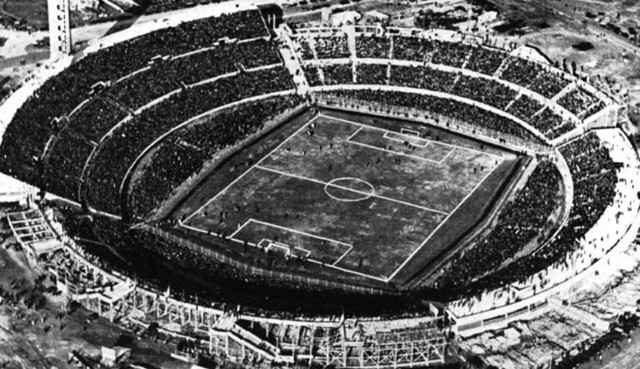
The first international match of any kind was played between Scotland and England in Glasgow in 1872. The first international tournament also involved those teams as well as Wales and Ireland when the British Home Championship was played in 1884. The game’s popularity grew throughout the world during the late part of the 19th Century and at the 1900 and 1904 Summer Olympics matches were played as a ‘demonstration sport’, with no medals being awarded to participants.
FIFA was founded as an organisation in 1904 and in 1906 they attempted to arrange a tournament against international teams that was outside the framework of the Olympics. It didn’t really work and is largely considered to be a failure. The 1908 Summer Olympics in London saw football recognised as an official competition in the tournament for the first time, though it was only for amateurs. By 1914 FIFA finally accepted that the Olympics’ football tournament wasn’t going anywhere so they recognised it as a ‘world football championship for amateurs’ and agreed to be responsible for the event’s management.
The 1920 Summer Olympics saw the world’s first intercontinental football tournament, as Egypt went up against fourteen European teams and Belgium ran out as the overall winners. Two more Olympic Games football tournaments took place in 1924 and 1928, with Uruguay winning both of them. Such was the popularity of these tournaments that FIFA decided that they wanted a piece of the action. Still smarting from their own failed tournament in 1906, the organisation set about trying to make sure they got it right this time.
Given that Uruguay had won the last two football tournaments in the Summer Olympics it seemed only right that FIFA should ask them to host the inaugural ‘World Championship’. Jules Rimet, the organisation’s president at the time, was the major driving force behind this new World Cup and for a time it looked like it might be another failure. The cost of travelling to South America was prohibitive for European teams and up until two months before the start of the tournament it looked like none would be going.
Eventually Rimet was able to persuade Belgium, France, Romania and Yugoslavia to head to Uruguay for the competition, with seven South American teams and two North American teams joining them in the contest. The hosts beat Argentina 4-2 in the final in Montevideo and over 93,000 people saw them become the first ever winners of the World Cup. The 1932 Summer Olympics were held in Los Angeles and the lack of popularity of football in America meant that it was dropped from the IOC’s list of sports that would be competed at the event. Two more World Cups took place in 1934 and 1938 as the competition became more prestigious than football in the Olympics, but the 1942 and 1946 World Cups were both cancelled because of the Second World War and it’s aftermath.
After The War And The Competition’s Expansion
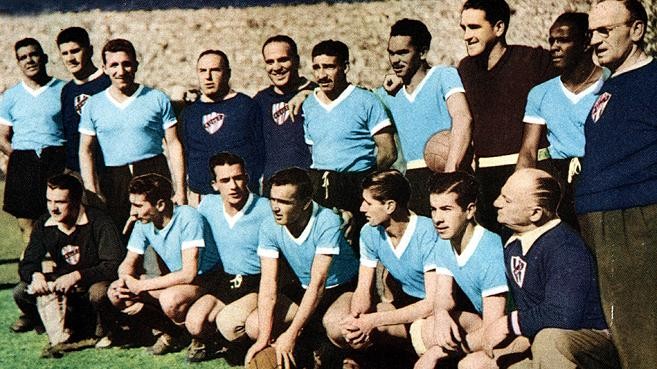
The World Cup resumed as a contest in 1950. It was hosted by Brazil and was the first of the tournaments to feature British teams. British teams had actually not been part of FIFA since 1920 as they were unwilling to play matches against countries that they had been at war with and they were also unimpressed with the influence of foreign countries on a game that they felt they had invented. They returned to the FIFA family in 1946 and so the 1950 tournament was the first they were able to compete in. It also saw the return of Uruguay who had boycotted the previous two tournaments, with the South American country going on to beat the hosts in the final.
Between 1934 and 1978 the World Cup was competed between sixteen teams, apart from in 1938 when Austria got absorbed into Germany after the qualifying phase meaning that only fifteen teams took part. Also, in 1950, India, Scotland and Turkey withdrew meaning that only thirteen teams played. The majority of the teams that played in the World Cup were from Europe and South America. Very few participants were from North America, Asia, Oceania or Africa.
In 1982 a decision was taken to expand the competition to 24 teams. This remained the case until 1998 when it was expanded once more to allow 32 teams to take part. The idea was that more teams from the likes of Africa and Asia would be able to take part if the competition was expanded in this way. Whilst that is exactly what happens, European and South American teams continue to dominate the World Cup to this day.
1966 And All That
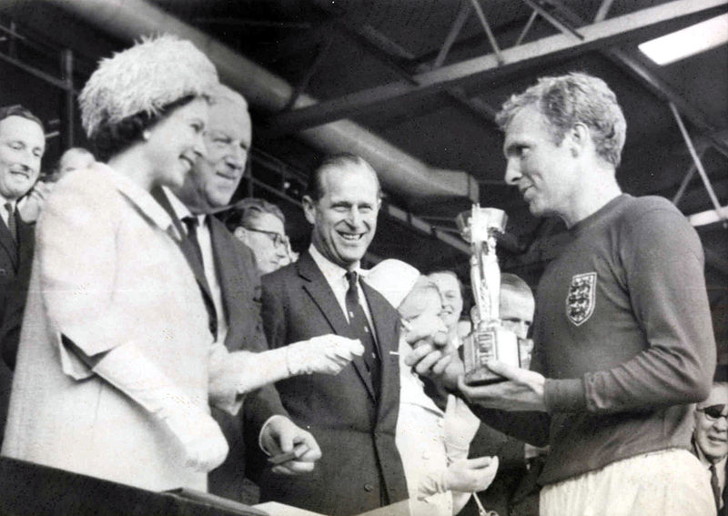
Speak to any Englishman about the World Cup and only one thing will be on their mind. In 1966 England hosted the World Cup finals for the only time in the competition’s history to date. The hosts finished top of their group and qualified for the knockout stages with Uruguay. They were drawn to play Argentina in the quarter-finals and bear them 1-0 at Wembley, earning the right to face Portugal in the semi-finals after they’d beaten North Korea 5-3 in the quarters. England won 2-1, putting them through to the final of the World Cup for the first time.
In the other strand of matches West Germany had beaten Uruguay 4-0 in the quarters and the Soviet Union 2-1 in the semis, setting up a clash between the old enemy that would be the ultimate showdown on a football pitch for the first time since the end of the Second World War. With Portugal beating the Soviet Union 2-1 for third place the stage was set for a blockbuster final and neither team disappointed.
Helmut Haller gave West Germany the lead after just 12 minutes before Geoff Hurst equalised 6 minutes later. Martin Peters thought he’d won it for the home nation when he struck after 78 minutes, but Wolfgang Weber struck just a minute from the whistle being blown to send the game to extra-time.
Extra-time was a close affair up until Hurst scored to put England 3-2 up. Or did he? Even to this day there remains some controversy over Hurst’s goal which was awarded after the ball struck the crossbar and appeared to cross the line. Computers have since been used to reconstruct the event, which was the last World Cup final to be broadcast in black and white, and they suggest it didn’t cross the line. Regardless Hurst struck again two minutes before the end of extra-time to put the game beyond doubt and led to the match commentator, Kenneth Wolstenholme, delivering a line that has gone down in folklore. As a celebratory pitch invasion began just before Hurst scored he said, “Some people are on the pitch. They think it’s all over. It is now!”
World Cup Stadiums
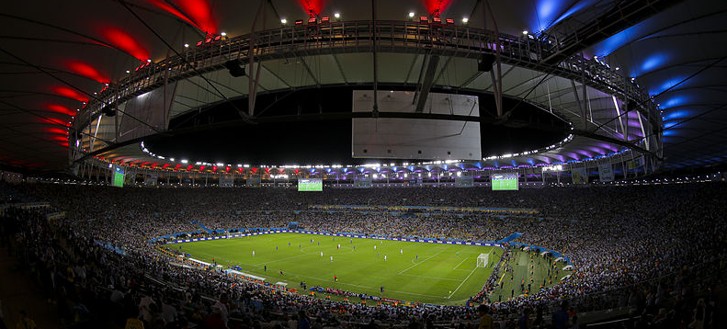
The host nation or nations of the World Cup suggest which stadiums will be used for the competition when they tender their bid to host the competition. In some cases, such as when Qatar host the tournament in 2022, this involves brand new stadiums that don’t exist yet being built in time for the arrival or the world’s best teams.
Ordinarily the final of the World Cup is held in the largest and most prestigious stadium in the country. When England hosted to tournament in 1966, for example, the final was held in the old Wembley Stadium with 96,924 people in attendance. The Estadio Centenario in Uruguay hosed the first ever World Cup final and 80,000 people watched the hosts bear Argentina, Whilst an incredible 174,000 supporters packed into the Estadio do Maracana in Brazil to watch the same team beat the hosts in 1950.
That is the best attended final to date, with the next closest seeing 114,600 attend the Estadio Azteca in Mexico City in order to watch Argentina beat West Germany 3-2 in 1986, the year that Maradona’s famous ‘Hand Of God’ goal knocked England out. Only three stadiums have held the World Cup final more than once. The Estadio Azteca did so in 1970 and 1986, the Estadio do Maracana did so in 1950 and 2014 and the Olympiastadion in Munich, Germany, hosted the 1974 and 2006 finals. The most amusing name of a stadium that has hosted a World Cup final is the Wankdorf Stadium in Bern, Switzerland that was used for the 1954 tournament.
Previous Tournaments
World Cup 2022
A Lionel Messi inspired Argentina claimed their third World Cup at the expense of Kylian Mbappe led defending champions France in a pulsating final that ended 2-2 in 90 mins, 3-3 after extra-time and 4-2 on penalties. The Lusail Iconic Stadium in Qatar hosted the final on 18th December 2022.
World Cup 2018
France beat unexpected finalists Croatia 4-2 in the highest scoring final since 1966. The final was held at the Luzhniki stadium in Moscow on the 15th July 2018.
